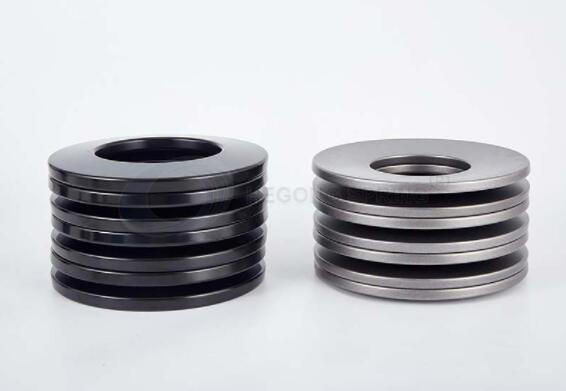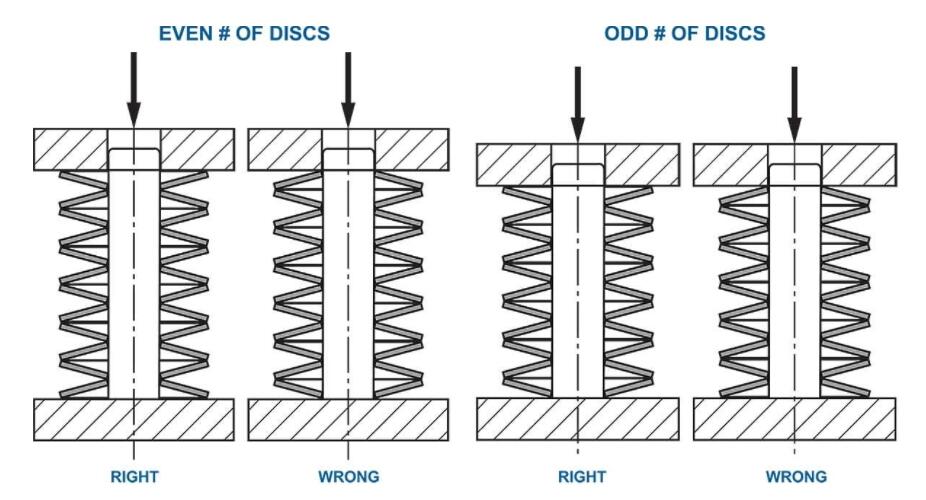Disc springs are conical, washer-type components designed to withstand static loads continuously or intermittently, or dynamic loads with continuous load cycles. Disc springs are unique in that the deflection for a given load is predictable based on standardized calculations.
Optimal disc spring performance is achieved with working deflections between 15% and 75% of full deflection, as this is the range where the theoretical properties and measurements are most accurately matched. If a single disc spring does not meet the force/deflection characteristics required by the application, disc springs can be used in series, parallel or in combination with stacked disc springs.
For parallel or combination stacks of disc springs, the friction between the parallel disc surfaces needs to be considered. Many factors can affect the amount of friction in a disc spring stack. These include, but are not limited to, surface roughness, the number of parallel stacked disc springs, and the amount of deflection. A reasonable margin is 2-3% of force per sliding surface - more force to load and less force to unload. Parallel stacks of disc springs should be adequately lubricated and limited to a maximum of 3-4 disc springs to reduce deviations in calculated and measured characteristics. Parallel stacked disc springs have enhanced self damping (hysteresis) characteristics.
A variety of force/deflection characteristics can be achieved when stacking disc springs; stacks can be designed with specific load profiles to meet progressive and regressive application requirements.

Placing the ends of the stack on the larger outer edges of the disc is desirable. If this is not possible, for example for an odd number of discs, the larger outer edge should be arranged at the end where the force is applied.
Shorter stacks are more efficient, which is especially important for dynamic applications. Due to friction between the disc spring and the guiding mandrel or sleeve, the disc spring at the moving end of the stack tends to deflect more than the disc spring at the other end. Using the largest practical diameter disc springs will reduce the number of disc springs per stack and the total stack height. It is recommended that the overall stack height be no more than 3 times the outside diameter of the disc spring or 10 disc springs in series. If desired, flat washers can be used to separate higher stacks to provide stability.

To keep the disc springs in place, the stack needs to be guided. The preferred method is internal guidance through the inner diameter, e.g. rod/ mandrel. In the case of external guidance, the use of a sleeve is recommended. In either case, the guiding parts should be surface hardened to 58 HRC with a depth of not less than 0.6 mm and a surface finish of ≤ 4 microns.
Since the diameter of the disc changes during compression, the following clearance values are recommended.
Progressive loading can be obtained by assembling stacks in which the disc springs are continuously deflected during loading by:
1. Tandem stacking of single, double and triple parallel sets.
2. Tandem stacking of disc springs of various thicknesses.
3. It is necessary to limit the deflection of the weaker disc springs to avoid over-compression, while the stronger disc springs or parallel packs are still in compression.
The process of installing Disc Spring Stacks in a production environment is often a manual, time-consuming process, which can introduce the opportunity for stack configuration errors. Instead of manually configuring the stack of disc springs, manufacturers can provide pre-stacked disc springs (lubricated or unlubricated). These stacks come in shrink-wrapped packages with perforated labels, allowing for a simple installation process that saves time and helps prevent errors in the assembly process.